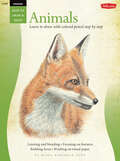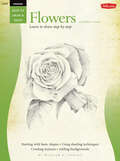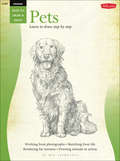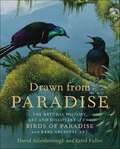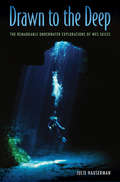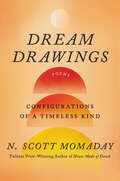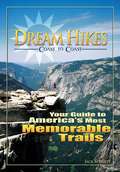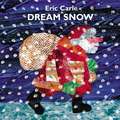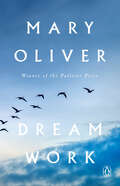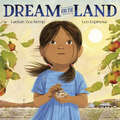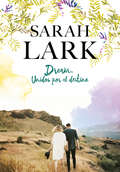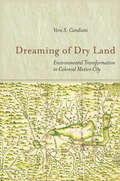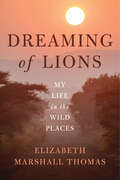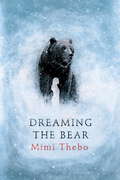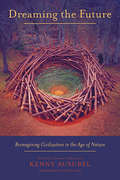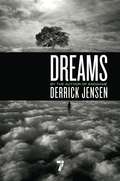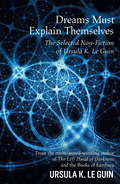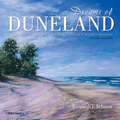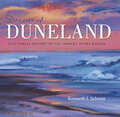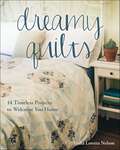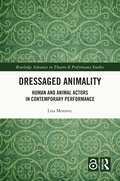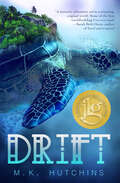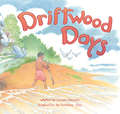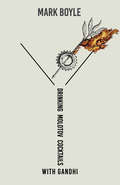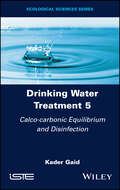- Table View
- List View
Drawing: Learn How to Draw with Colored Pencil, Step-by-Step (How to Draw & Paint)
by Debra Kauffman YaunAn easy to read, how-to guide with complete instructions for creating lifelike portraits of wild and domestic animals using colored pencils.In this comprehensive, thirty-two–page book, accomplished artist Debra Kauffman Yaun shares her artistic insights and techniques for creating strikingly realistic animal drawings in colored pencil. The book opens with essential information on choosing tools and materials, understanding color theory, and creating basic pencil strokes. It then covers special colored pencil techniques, such as hatching, burnishing, layering, and blending. Finally, the author demonstrates how to accurately depict an assortment of adorable animals—including favorite family pets, wildlife, and birds—in a series of clear, step-by-step lessons. In-depth, easy-to-follow instructions allow aspiring artists to develop their drawing skills, guiding them from simple sketches to the final flourishes.
Drawing: Learn To Paint Step By Step (How to Draw & Paint)
by William F. PowellIn this comprehensive guide, acclaimed artist William F. Powell invites you into his artistic world as he shows you how to render a variety of beautiful flowers in pencil. After sharing helpful tips for choosing materials, shading with pencil, and creating floral arrangements, he explores drawing techniques with step-by-step demonstrations that feature his own personal method for developing a drawing to its fullest potential. And the lessons feature a variety of beautiful flower drawings you can both copy and admire, making this book a welcome addition to any artistÆs library of reference.
Drawing: Pets (How to Draw & Paint)
by Mia TavonattiSeventeen pet portraits—from a sleek ferret to a majestic horse—plus tips on sketching from photos, rendering fur textures, and drawing animals in action.This is the perfect introductory kit for anyone who wants to learn how to depict a variety of irresistible pets in pencil. Inside is everything aspiring artists need to get started, presenting the basics of drawing in pencil and offering in-depth information on tools before guiding beginners through seventeen demonstrations—each accompanied by clear, step-by-step instructions. From traditional dogs and cats to more exotic reptiles and birds, this kit features a number of inspiring drawings that are sure to appeal to any pet-loving artist.
Drawn from Paradise: The Natural History, Art and Discovery of the Birds of Paradise with Rare Archival Art
by David Attenborough Errol FullerFrom the moment Europeans were introduced to the birds of paradise in the early sixteenth century, their unique beauty was recognized and commemorated in the first name that they were given - birds so beautiful they must be from paradise. Originally they were thought not to have legs and therefore never to land. Still very rarely encountered, even in their natural habitat of New Guinea, they are still birds that elicit sheer awe in those who are lucky enough to see them. Drawn From Paradise will showcase the magnificence and beauty of the birds of paradise as they have never before been seen, with more than two-hundred hand-painted images and sketches by the men who originally studied them and luminary artists such as Jacques Barraband, William Hart, John Gould, Rubens and Breughel, to name a few. The art comes from the private collections of the two authors and has been rarely if ever published. Not only will the book feature the beautiful Greater Bird of Paradise-a bird that was originally believed to have been sent from Paradise, and was thought to never touch the earth-but it will also present more than forty other distinct species currently recognized-each representing amazing differences in size, shape, and color patterning.The introduction provides a brief history into the discovery of these illustrious birds, from how they were originally perceived and idolized by the natives of New Guinea, to the arrival of Europeans, who were immediately captivated by their bright, vibrant colors. The chapters are ordered according to the sequence in which the birds representing the various genera made their appearance in Europe (thereby highlighting the books educational aspect). Within its pages, readers will catch a glimpse of these birds through vivid, highly-detailed painting, as well as learn more about each individual bird and genus-comparisons and contrasts between the males and females, as well as between the different genus's.A tour through art and history, with a good deal of ornithology thrown in, Drawn From Paradise is not only a must-have for ornithologists and bird-watchers, but also a beautiful collectible for students, artists, and aesthetes. Its central idea is to showcase the breathtaking beauty of these birds and the enormous interest that still surrounds them even today.
Drawn to the Deep: The Remarkable Underwater Explorations of Wes Skiles
by Julie HausermanDan's Cave looks like the entrance to the underworld. Two divers swim along a luminous blue-green passage, flashlights cutting through the water, a dark mass of stalactites suspended overhead. This is the breathtaking National Geographic cover photo taken by Wes Skiles (1958–2010), a top nature photographer who died in a diving accident before the issue was published. Drawn to the Deep celebrates the life of an extraordinary adventurer who braved extreme danger to share the hidden beauty and environmental truths of the planet with others. Skiles felt a pull to the water as a child, captivated by the cobalt springs of Florida. His passion for diving and his innovative camera techniques earned him assignments with National Geographic and Outside. He also took part in creating over a hundred films, many of which won international awards and acclaim. Skiles was a self-taught expert on Florida's freshwater springs and an outspoken advocate for their conservation. He went head to head with scientists and government officials who dismissed his firsthand observations of water movement through the "Swiss-cheese" karst rock of the underground aquifer. But he never gave up on his quest to disprove the prevailing scientific models or to protest what they allowed—the unchecked pumping and depletion of Florida's groundwater. Through interviews with Skiles's friends and family, along with insights from his own journals, Julie Hauserman describes the escapades and achievements that characterized his life's work. This book is the inspiring story of an explorer and activist who uncovered environmental abuses, advanced the field of underwater photography, and astonished the world with unprecedented views of the secret depths of the planet.
Dream Drawings: Configurations of a Timeless Kind
by N. Scott Momaday“[Momaday] must be ranked among the greatest of our contemporary writers.”—American ScholarFrom Pulitzer Prize winner and revered literary master N. Scott Momaday, a beautiful and enchanting new poetry collection, at once a celebration of language, imagination, and the human spirit.“Language and the imagination work hand in hand, and together they enable us to reveal us to ourselves in story. That is indeed a magical process. . . . We imagine and we dream, and we translate our dreams into language.” —from the PrefaceA singular voice in American letters, Momaday’s love of language and storytelling are on full display in this brilliant new collection comprising one hundred sketches or “dream drawings”—furnishings of the mind—as he calls them. Influenced by his Native American heritage and its oral storytelling traditions, here are prose poems about nature, animals, warriors, and hunters, as well as meditations that explore themes of love, loss, time, and memory. Each piece, full of wisdom and wonder, showcases Momaday’s extraordinary lyrical talent, the breadth of his imagination, and the transformative power of his writing. Dream Drawings is also illustrated with a selection of black-and-white paintings by Momaday that capture the spirit of his prose.Poignant, inspired, and timeless, this is a collection that will nourish the soul.
Dream Hikes Coast to Coast
by Jack BennettStarting in April 2000, Jack Bennett logged thousands of miles over seven years in his search for America's best hikes. In Dream Hikes Coast to Coast, Bennett shares how each hike looked and felt; what weather and animals were encountered; and the emotional impact of every event and panorama. Individual hikes are accompanied by maps showing the trailhead, routes, and topographic landmarks. Camping, lodging, fees, and contact information are also presented for each hike.
Dream Snow
by Eric CarleIt's December 24th, and the old farmer settles down for a winter's nap, wondering how Christmas can come when there is no snow! It is in his dream that he imagines a snowstorm coming and covering him and his animals--named One, Two, Three, Four and Five--in a snowy blanket.<P><P> But when the farmer awakens, he finds that it has really snowed outside, and now he remembers something! Putting on his red suit, he goes outside, puts some gifts under the tree for his animals, and presses a button near a Christmas tree, creating a most surprising musical treat for children everywhere.
Dream Work
by Mary OliverNewly repackaged as a Penguin paperback, an &“astonishing&” book of poetry from the Pulitzer Prize–winning author of American Primitive and &“one of our very best poets&” (New York Times Book Review)Dream Work, a collection of forty-five poems originally published in 1986, follows both chronologically and logically Mary Oliver&’s American Primitive, which won her the Pulitzer Prize for poetry in 1983. The depth and diversity of perceptual awareness, so steadfast and radiant in American Primitive, continues in Dream Work. Additionally, she has turned her attention in these poems to the solitary and difficult labors of the spirit, to accepting the truth about one&’s personal world, and to valuing the triumphs while transcending the failures of human relationships.
Dream for the Land
by Laekan Zea KempIn this lyrical picture book about the importance of caring for our Earth, a child and her father wish for a brighter, greener future for the parched land around their home.When a girl finds a horned toad among the rain-starved squash, tomatoes, and poblanos on her family's Texas farm, her Pa tells her that, if she kisses it on the head -- blech! -- she gets to make one wish. What will she wish for?Generations ago, when the girl's ancestors lived on this land, it was lush and green -- full of life. Now, because of a decades-long drought, their soil is parched and their crops are dying.The girl sees the worry lines on Pa's face getting deeper. She knows she has to do something to help. And so, thinking about the people who lived on this land before her, and all those who will live on it after her, she wishes for rain.This poignant father-daughter story reminds us that, when it comes to healing our Earth, change often starts with a simple wish. With a dream for a world that could be.
Dream. Unidos por el destino
by Sarah LarkDream. Unidos por el destino, es la segunda novela juvenil de la autora best seller Sarah Lark. Magníficamente escrita, invita al lector a disfrutar de una mágica historia el amor y la libertad. Sarah se muda con sus padres a Nueva Zelanda. A pesar de los paisajes de ensueño, Sarah no puede evitar echar de menos su antiguo hogar en Alemania, las cuadras y, sobre todo, al caballo del que se ocupaba allí. Empieza a interesarse por su nuevo hogar cuando, junto al atractivo y misterioso Lucas, descubre los caballos salvajes del monte Kaimanawa. Sarah se prenda de un semental plateado al que bautiza en secreto como Dream. Cuando Sarah se entera de que los caballos van a ser apresados y domados para hacer sitio al ejército, que necesita construir un campo de maniobras, Sarah está en shock. Para colmo, Dream acaba en manos de un brutal tratante de caballos y Sarah no puede evitar obsesionarse con una idea: ¿Cómo puede devolverle la libertad a Dream?
Dreaming of Dry Land: Environmental Transformation in Colonial Mexico City
by Vera S. CandianiNot long after the conquest, the City of Mexico's rise to become the crown jewel in the Spanish empire was compromised by the lakes that surrounded it. Their increasing propensity to overflow destroyed wealth and alarmed urban elites, who responded with what would become the most transformative and protracted drainage project in the early modern America—the Desagüe de Huehuetoca. Hundreds of technicians, thousands of indigenous workers, and millions of pesos were marshaled to realize a complex system of canals, tunnels, dams, floodgates, and reservoirs. Vera S. Candiani's Dreaming of Dry Land weaves a narrative that describes what colonization was and looked like on the ground, and how it affected land, water, biota, humans, and the relationship among them, to explain the origins of our built and unbuilt landscapes. Connecting multiple historiographical traditions—history of science and technology, environmental history, social history, and Atlantic history—Candiani proposes that colonization was a class, not an ethnic or nation-based phenomenon, occurring simultaneously on both sides of an Atlantic, where state-building and empire-building were intertwined.
Dreaming of Lions: My Life in the Wild Places
by Elizabeth Marshall ThomasElizabeth Marshall Thomas has spent a lifetime observing other creatures and other cultures, from her own backyard to the African savannah. Her books have transported millions of readers into the hidden lives of animals—from dogs and cats to deer and lions. She&’s chronicled the daily lives of African tribes, and even imagined the lives of prehistoric humans. She illuminates unknown worlds like no other. Now, she opens the doors to her own.Dreaming of Lions traces Thomas&’s life from her earliest days, including when, as a young woman in the 1950s, she and her family packed up and left for the Kalahari Desert to study the Ju/Wa Bushmen. The world&’s understanding of African tribal cultures has never been the same since. Nor has Thomas, as the experience taught her not only how to observe, but also how to navigate in male-dominated fields like anthropology and animal science and do what she cared about most: spending time with animals and people in wild places, and relishing the people and animals around her at home.Readers join Thomas as she returns to Africa, after college and marriage, with her two young children, ending up in the turmoil leading to Idi Amin&’s bloody coup. She invites us into her family life, her writing, and her fascination with animals—from elephants in Namibia, to dogs in her kitchen, or cougars outside her New England farmhouse. She also recounts her personal struggles, writing about her own life with the same kind of fierce honesty that she applies to the world around her, and delivering a memoir that not only shares tremendous insights, but also provides tremendous inspiration.Dreaming of Lions, originally published in hardcover as A Million Years With You, is slightly updated and includes a powerful new afterword by the author.
Dreaming the Bear
by Mimi TheboA vivid sense of the wilderness and nature’s power comes through in this intriguing and tension-filled YA novel narrated by a contemporary teen. Perfect for animal lovers, this unusual novel has hints of the quirky charm of Geek Girl and the emotional depth of The Last Leaves Falling. Darcy’s dad, a naturalist, moves their family from England to the snowy wilderness of Yellowstone National Park. Mum, Dad, and older brother Jem are all thriving, but Darcy misses her friends, and civilization, including WiFi. She’s also sick, getting weaker with each day, and having strange dreams—or are they something else? Then she finds an injured mother bear whose cubs were killed by hunters. The bear is enormous, and powerful, but she doesn’t threaten Darcy—she makes Darcy feel alive. The bear needs Darcy just as much as Darcy needs her. Darcy must help her, even though she might not be well enough to take care of the bear, let alone herself. A mystery illness, shifting points of view, and dreamlike sequences make this an unusual and immersive story. Darcy is brave and resourceful, but nothing has prepared her to confront nature’s ultimate question: Can a girl and a wild bear triumph over the basic rule of survival: kill or be killed?
Dreaming the Future: Reimagining Civilization in the Age of Nature
by Kenny Ausubel David W. OrrFew would deny that we are entering a period of great change. Our environment is collapsing. Social disruption abounds. All around, it seems, we are experiencing breakdown. But out of this chaos comes the opportunity for breakthrough-the opportunity to reimagine our future. In Dreaming the Future, Kenny Ausubel leads us into that possible new world and introduces us to the thinkers and doers who are-sometimes quietly, sometimes not-leading what he calls "a revolution from the heart of nature and the human heart." In a collection of short, witty, poignant, even humorous essays, Ausubel tracks the big ideas, emerging trends, and game-changing developments of our time. He guides us through our watershed moment, showing how it's possible to emerge from a world where corporations are citizens, the gap between rich and poor is cavernous, and biodiversity and the climate are under assault and create a world where we take our cues from nature and focus on justice, equity, diversity, democracy, and peace. Even those steeped in the realities of a world gone wrong and efforts to right it will find refreshing, even surprising, perspectives in Dreaming the Future. It will come as no surprise to readers that Ausubel is cofounder of Bioneers-which foreword author David W. Orr describes as "one part global salon...one part catalytic organization."
Dreams
by Derrick JensenJensen's furthest-reaching book yet, Dreams challenges the "destructive nihilism" of writers like Richard Dawkins and Sam Harris who believe that there is no reality outside what can be measured using the tools of science. He introduces the mythologies of ancient cultures and modern indigenous peoples as evidence of alternative ways of understanding reality, informed by thinkers such as American Indian writer Jack Forbes, theologian and American Indian rights activist Vine Deloria, Shaman Martin Prechtel, Dakota activist and scholar Waziyatawin, and Okanagan Indian writer Jeannette Armstrong. He draws on the wisdom of Dr. Paul Staments, author of Mycelium Running: How Mushrooms Can Help Save the World, sociologist Stanley Aronowitz, who discusses science's lack of accountability to the earth, and many more. As in his other books, Jensen draws heavily from his own life experience living alongside the frogs, redwoods, snails, birds and bears of the upper northwest, about which he writes with exquisite tenderness.Having taken on the daunting task of understanding one's dreams as a source of knowledge, Jensen achieves the near-impossible in this breathtakingly brave and ambitious new work.
Dreams Must Explain Themselves: The Selected Non-Fiction of Ursula K. Le Guin
by Ursula K. Le Guin'By turns sharp, funny and insightful, high-minded but never mean-spirited, the book embodies its author's lifelong quest for freedom: freedom as a woman, freedom to write what she pleased, freedom to like what she liked. Genre fiction - and literature in general - has lost not just one of its brightest exponents but one of its bolshiest champions.' FINANCIAL TIMES'Excellent' CHOICE'Le Guin is one of the singular speculative voices of our future, thanks to her knack for anticipating issues of seminal importance to society' TLSUrsula K. Le Guin has won or been nominated for over 200 awards for her fiction, including the Hugo, Nebula, World Fantasy and SFWA Grand Master Awards. She is the acclaimed author of the Earthsea sequence and The Left Hand of Darkness - which alone would qualify her for literary immortality - as well as a remarkable body of short fiction, including the powerful, Hugo-winning 'The Ones Who Walk Away from Omelas' and the masterpiece of anthropological and environmental SF 'The Word for World is Forest' - winner of the Hugo Award for best novella. But Ursula Le Guin's talents do not stop at fiction. Over the course of her extraordinary career, she has penned numerous essays around themes important to her: anthropology, environmentalism, feminism, social justice and literary criticism to name a few. She has responded in detail to criticism of her own work and even reassessed that work in the context of such critiques. This selection of the best of Le Guin's non-fiction shows an agile mind, an unparalleled imagination and a ferocious passion to argue against injustice. In 2014 Ursula Le Guin was awarded the National Book Foundation's Medal for Distinguished Contribution to American Letters, and her widely praised acceptance speech is one of the highlights of this volume, which shows that one of modern literature's most original voices is also one of its purest consciences.
Dreams of Duneland: A Pictorial History of the Indiana Dunes Region
by Kenneth J. SchoonThe towering sand dunes along Lake Michigan, not far from Chicago, are one of the most unexpected natural features of Indiana.The second edition of Dreams of Duneland beautifully illustrates the dunes region, from the past to the present. Since the first edition, the Indiana Dunes area has become an official national park. With more than 400 stunning images, many of them new, Dreams of Duneland showcases the breathtaking sand dunes, as well as the rest of this newly minted park, which includes savanna, wetland, prairie, and forest and is home to a wide variety of plant and animal species. Kenneth J. Schoon reveals how the preserved area of the Indiana Dunes National Park—which sits by residential communities, businesses, and cultural attractions—has a long history of competition among farmers, fur traders, industrialists, and conservationists. Featuring a new foreword and afterword and many updates throughout, this gorgeous new edition will have you planning a trip to the extraordinary Indiana Dunes.
Dreams of Duneland: A Pictorial History of the Indiana Dunes Region
by Kenneth J. SchoonThe towering sand dunes along Lake Michigan not far from Chicago are one of the most unexpected natural features of Indiana. Dreams of Duneland is a beautifully illustrated introduction to the Dunes region, its history, and future prospects. This area of shifting sands is also a place of savanna, wetland, prairie, and forest that is home to a wide diversity of plant and animal species. The preserved area of the Indiana Dunes National Lakeshore sits by residential communities, businesses, and cultural attractions, evidence of a long history of competition for the land among farmers, fur traders, industrialists, conservationists, and urban and recreational planners. With more than 400 stunning images, the book brings to life the remarkable story of this extraordinary place.
Dreamy Quilts: 14 Timeless Projects to Welcome You Home
by Lydia Loretta NelsonHome is where the quilt is Transform your living space into a relaxing retreat when you stitch up soft, simple, and naturally beautiful quilts. Fourteen easy-to-sew projects range from quilts and throw pillows to a pretty patchwork dog bed. Author and designer Lydia Loretta Nelson’s soothing, handmade touches lend a touch of warmth to every room in your home—including all the spaces where memories are made. Fold a quilt over the nursery rocker or drape a patchwork throw over the sofa to personalize your house, apartment, or dorm room. Quilters of all skill levels will appreciate Lydia’s fresh designs and timeless, calming color palettes. 14 easy patchwork and appliqué projects include quilts, pillows, and a pet bed Low volume quilts lend a lovely, welcoming feel to any home decor Create timeless decor to personalize your living space—dream houses and temporary digs alike
Dressaged Animality: Human and Animal Actors in Contemporary Performance (Routledge Advances in Theatre & Performance Studies)
by Lisa MoravecThe book applies a productive interdisciplinary lens of art history, performance, and animal studies for approaching political economy issues, critiquing anthropomorphic worldviews, and provoking thoughts around animal and human nature that spark impulses for an innovative performance aesthetics and ethics.It combines Marxist analysis with feminist and posthumanist methodology to analyse the relation between ‘societal dressage’ and ‘bodily animality’ that humans and animals share. Within this original theoretical framework, the book develops the concept of ‘dressaged animality’ as a mode of critique to analyse the social and political function of interdisciplinary forms of ‘contemporary performances.’Drawing on archival and primary research, the book theorises and historicises more than 15 performance practices in which animality is allegorically staged through by humans danced, real, or filmically mediated animals. It focuses on Rose English’s pioneering approach to performance-making as well as on overlooked performances by other renown and largely unknown American (Mike Kelley/Kate Foley, Robert Morris, Bruce Nauman, Yvonne Rainer, Diana Thater), British (Mark Wallinger, Rose English), and European artists (Tamara Grcic, Judith Hopf, Joseph Beuys, Bartabas) from the late 1960s until the late 2010s. While various types of artistic practice are framed as forms of critique (for example, protest art, interventionist strategies, institutional critique), the book maps an original performance theory in art which shows that contemporary artistic performances can also take up a critique of societal dressage.This study will be of great interest to students and scholars in art history, theatre, dance and performance studies, and ecology, as well as to artists and curators working with performance.
Drift
by Megan HutchinsTenjat joins a dangerous defense to protect his island home from the monsters who threaten it in this fresh YA fantasy inspired by Mayan and Indian folklore.There's no place for love on the shores of Hell. Tenjat lives on the shores of Hell, an ocean filled with ravenous naga monsters. His island, a massive Turtle, is slowed by the people living on its back. Tenjat is poor as poor gets: poor enough, even, to condescend to the shame of marriage, so his children can help support him one day. But Tenjat has a plan to avoid this fate. He will join the Handlers, those who defend and rule the island. Handlers never marry, and they can even provide for an additional family member. Against his sister's wishes, Tenjat joins the Handlers. And just in time: the Handlers are ramping up for a dangerous battle against the naga monsters, and they need every fighter they can get. As the naga battle approaches, Tenjat's training intensifies, but a long-hidden family secret-not to mention his own growing feelings for Avi-put his plans in jeopardy, and might threaten the very survival of his island.
Driftwood Days
by William MiniverUnder autumn leaves, a boy watches a beaver build a dam. One of the branches slips away, carried downstream by the river. Through the changing seasons, the branch makes a long, epic journey to the sea, before finally getting tossed back onto shore. Changed by the elements, the branch—now driftwood—lies patiently on the beach, until the boy discovers it once again.Featuring breathtaking artwork by Charles Vess, Driftwood Days offers readers a beautiful, multilayered story about nature, science, childhood, and change.
Drinking Molotov Cocktails with Gandhi
by Mark BoyleMore than ever, people are longing for deep and meaningful change. Another world is not only possible; it is essential. Yet despite our creative and determined efforts to attain social justice and ecological sustainability, our global crises continue to deepen.In Drinking Molotov Cocktails with Gandhi, best-selling author Mark Boyle argues that our political and economic system has brought us to the brink of climate catastrophe, ransacking ecosystems and unraveling communities for the benefit of the few at the expense of the many. He makes a compelling case that we must "rewild" the political landscape, as history teaches us that positive social change has always been wrought by movements prepared to use any means available.The time has come for pacifists, revolutionaries, and freedom fighters to work together for the creation of a world worth sustaining. Eloquent, visionary, and beautifully written, this incendiary manifesto strikes at the heart of the world's crises and reframes our understanding of how to solve them, signaling a turning point in our journey towards an ecologically just society.The three R's of the climate change generation--reduce, reuse, and recycle--are long overdue for an upgrade .Welcome to resist, revolt, rewild.Mark Boyle is the author of The Moneyless Man and The Moneyless Manifesto. He lived completely without money for three years, and is a director of the global sharing community streetbank.com.
Drinking Water Treatment, Calco-carbonic Equilibrium and Disinfection
by Kader GaidToday, hundreds of millions of people drink contaminated water without knowing it. Yet water treatment technologies can effectively eliminate contamination and can supply urban and rural populations with safe drinking water in a secure way. For almost two centuries, the huge number of treatments available to guarantee water quality has grown alongside technological progress, the strengthening of industry norms and the reinforcement of consumer expectations. New treatment methods have been developed according to the advancement of knowledge and new sanitary regulations. This five-volume book sets out to clearly present the variety of treatments available along with their performance, limitations and conditions of use as well as ways to combine them to produce safe drinking water, which is a basic need essential to everyday life. The author shares his expertise acquired at Veolia, a company that is a world leader in water services and sanitation, desalination of sea water and the recycling of wastewater. Founded in France in 1853 to bring safe water to populations and to protect them from waterborne epidemics which ravaged cities, its history is intertwined with that of water treatment.
